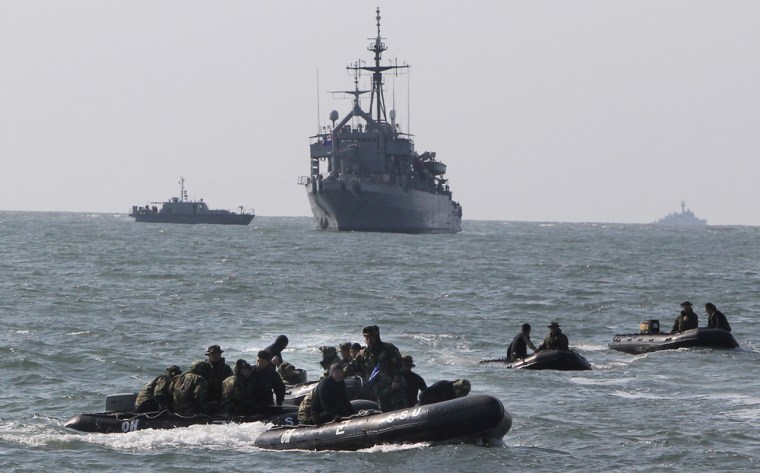A naval mine dispatched from North Korea may have struck the South Korean warship that exploded and sank near the Koreas' disputed sea border, the defense minister said as he laid out several scenarios for the maritime disaster.
Defense Minister Kim Tae-young told lawmakers Monday there was no sign of a direct attack from rival North Korea, but military authorities have not ruled out North Korean involvement in the sinking of the Cheonan late Friday night.
An explosion ripped the 1,200-ton ship apart during a routine patrol mission near Baengnyeong Island west of the peninsula. Fifty-eight crew members, including the captain, were plucked to safety; 46 remain missing.
The Joint Chiefs of Staff said the exact cause would remain unclear until the ship is salvaged after the rescue operation is over. On Monday, mothers beat their chests with grief as divers went down to search for survivors, returning to report hearing no sounds inside the underwater wreckage.
Nations remain in a state of war
Kim, grilled by lawmakers on what happened Friday night, said the ship may have struck a mine left over from the war or deliberately dispatched from the North.
The two Koreas remain in a state of war because their three-year conflict ended in a truce, not a peace treaty, in 1953. North Korea disputes the sea border drawn by the United Nations in 1953, and the western waters near the spot where the Cheonan went down have been the site of three bloody skirmishes between North and South.
Many of the 3,000 Soviet-made naval mines North Korea planted in the waters off both coasts during the war were removed, but not all. Kim noted a North Korean mine was discovered as recently as 1984.
North Korea may also have sent a mine floating south with the current, he said.
"North Korea may have intentionally floated underwater mines to inflict damage on us," Kim told lawmakers.
He insisted there were no South Korean mines off the west coast, and ruled out a torpedo attack from North Korea, which would have been spotted by radar.
Officials have also said an internal malfunction may be to blame. The 1,200-ton Cheonan is designed to carry weapons, and was involved in a previous skirmish with North Korea.
U.S. and South Korea military officials said there was no outward indication that North Korea was involved in the sinking of the Cheonan.
However, "neither the government nor the defense ministry has ever said there was no possibility of North Korea's involvement," Kim said.
No mention of the ship
The North Korean military was keeping a close watch on the search operation, the Joint Chiefs of Staffs said in a defense committee report cited by the Yonhap news agency.
But Pyongyang's state media have made no mention of the ship.
Earlier Friday, North Korea's military warned of "unpredictable strikes" if the U.S. and South Korea attempted to topple the regime. On Monday, a military spokesman accused the countries of engaging in "psychological warfare" by letting journalists into the Demilitarized Zone.
South Korean President Lee Myung-bak urged rescuers not to give up hope.
But the prospect of pulling anyone out alive seemed dim Monday. Any navy crewmen who managed to seal themselves inside their watertight cabins would have run out of air by Monday night since the supply of oxygen in the cabins was estimated to last up to 69 hours, military officials said.
Rough waves prevented divers from gaining access to the wreckage. Divers finally reached the ship's rear segment, where most of the missing were believed trapped, on Monday. They hammered on the hull but got no response, Rear Adm. Lee Ki-sik of the Joint Chiefs of Staff told reporters.
The U.S. Navy sent four ships and a team of divers to join the search, said Lt. Anthony Falvo, a spokesman for the 7th Fleet in Japan.
Anguished relatives waited for news at a naval base in Pyeongtaek, south of Seoul, some pounding their chests with grief, others shouting their displeasure at the slow pace of the rescue.
"My baby, my baby," one mother murmured, briefly losing consciousness.
"The navy is rotten to the core!" a man yelled, lunging at soldiers standing arm in arm to block angry family members from barging into the command center.
